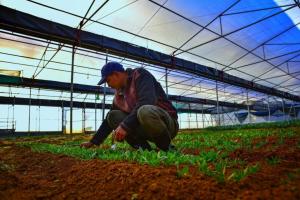
A farm stay resort in Southeast Asia provides bicycles for rent to tourists. Photo credit: ADB
UNWTO sees visitor arrivals nearing pre-pandemic levels in some regions but notes slow recovery in Asia–Pacific.
After a stronger than expected recovery in 2022, international tourist arrivals could reach 80% to 95% of pre-pandemic levels this year, says the United Nations World Tourism Organization (UNWTO) based on latest data. However, this will depend on several factors: the extent of the economic slowdown, the ongoing recovery of travel in Asia and the Pacific, and the evolution of the Russian invasion in Ukraine.
UNWTO notes that tourism in Asia and the Pacific was slow to recover compared with other regions.
More than 900 million tourists travelled internationally in 2022—double the number recorded in 2021 though still 63% of pre-pandemic levels. The Middle East enjoyed the strongest increase as arrivals climbed to 83% of pre-pandemic numbers. Europe reached nearly 80% of pre-pandemic levels as it welcomed the lion’s share of arrivals at 585 million in 2022. Africa and the Americas both recovered about 65% of their pre-pandemic visitors, while Asia and the Pacific reached only 23%, due to stronger pandemic-related restrictions, which have started to be removed only in recent months.
Strong demand for domestic and regional travel
The recent lifting of COVID-19-related travel restrictions in the People’s Republic of China, the world’s largest outbound market in 2019, is a significant step for the recovery of the tourism sector in Asia and the Pacific and worldwide.
Strong demand from the United States, backed by a strong US dollar, is also seen to continue benefitting destinations in the region and beyond.
UNWTO Secretary-General Zurab Pololikashvili said: “A new year brings more reason for optimism for global tourism. UNWTO anticipates a strong year for the sector even in the face of diverse challenges. including the economic situation and continued geopolitical uncertainty. Economic factors may influence how people travel in 2023, and UNWTO expects demand for domestic and regional travel to remain strong and help drive the sector’s wider recovery.”
Tourism spending: more or less?
International tourism receipts also increased across most destinations, in several cases higher than their growth in arrivals. The economic situation this year, however, could translate into tourists adopting a more cautious attitude in 2023, with reduced spending, shorter trips, and travel closer to home.
Meanwhile, a study by the World Travel & Tourism Council (WTTC) and Trip.com Group, together with Deloitte, shows tourists may be willing to spend more for sustainable travel options.
Surveys included in the joint report say three quarters of travelers are considering traveling more sustainably in the future, nearly 60% have chosen more sustainable travel options in the last couple of years, and around three quarters of high-end travelers are willing to pay extra to make their trips more sustainable. A survey also reveals that nearly 60% of travelers were either already paying to offset their carbon emissions or considering it if the price was right.
The rise of sustainable travel is an opportunity for tourism players to expand and capitalize on their efforts to protect nature, become more environmentally sustainable, and reduce their carbon footprint. These include low-carbon vacations (e.g., cycling holidays), ecotourism, and promoting sustainability practices, such as waste recycling, energy- and water-saving measures, and reducing or removing single-use plastic in their amenities.
This article was first published by BIMP-EAGA on 31 January 2023.

BIMP-EAGA
The Brunei Darussalam–Indonesia–Malaysia–Philippines East ASEAN Growth Area, or BIMP-EAGA, is a cooperation initiative established in 1994 to spur development in remote and less developed areas in the four participating Southeast Asian countries.


